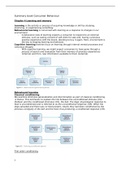Samenvatting
Summary MCB20806 book Consumer Behaviour chapter 3, 4, 6, 8, 9, 10
- Instelling
- Wageningen University (WUR)
- Boek
- Consumer Behaviour
Summary book Consumer Behaviour by Isabelle Szmigin, chapter 3, 4, 6, 8, 9, 10. Course Principles of Consumer Studies 20806
[Meer zien]










